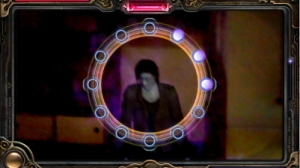 The survival horror genre has mutated over time with the injection of new technology. Mostly gone are the days of slowly and deliberately making one’s way through a puzzle-filled map with few strategically placed foes. As later console generations became more graphically slanted, survival horror slowly dissolved to be replaced by what can only be described as the horror first person shooter genre. Spirit Camera: The Cursed Memoir for the 3DS is a unique entry into the horror genre, because it evolves with the new 3D and augmented reality (AR) capabilities of the 3DS while including gameplay that harkens back to the survival horror games found in earlier generations. Unfortunately, the results are mixed.
The survival horror genre has mutated over time with the injection of new technology. Mostly gone are the days of slowly and deliberately making one’s way through a puzzle-filled map with few strategically placed foes. As later console generations became more graphically slanted, survival horror slowly dissolved to be replaced by what can only be described as the horror first person shooter genre. Spirit Camera: The Cursed Memoir for the 3DS is a unique entry into the horror genre, because it evolves with the new 3D and augmented reality (AR) capabilities of the 3DS while including gameplay that harkens back to the survival horror games found in earlier generations. Unfortunately, the results are mixed.
Spirit Camera offers a main story mode along with a regular camera mode and some smaller puzzles that work with AR. The story and puzzles require the booklet insert, referred to as the Diary of Faces in the game, to be played at all. The pages of this booklet will spring to life when viewed through the 3DS camera at the appropriate times. This allows for some exciting and thoroughly creepy new methods of frightening the player. These efforts seem limited by the technology of the 3DS itself, due to the camera needing a very well lit area to view things through the camera. Most indoor lighting conditions are not good enough, and anything brighter than this will often lead to screen glare and awkward angles when holding the 3DS.
The tragically short story mode suffers from these lighting woes at an even higher cost. The story is overdone and borrowed from other titles, most heavily the Fatal Frame series. They even refer to their camera in the game as the “Camera Obscura,” which is also the name of the camera used in Fatal Frame. The game play is remarkably similar, too, revolving around a player targeting ghosts within the camera lens and shooting pictures at just the right moment to cause massive damage. This isn’t a complaint, however, as Fatal Frame is a great game, and the ability to view ghosts in one’s own setting only adds an even more frightening element to the game. However, due to the low light limitations, one has to find an area that is well lit and offers a wealth of room to turn, walk, and explore during the story. It also must have a surface for the player to set down the Diary of Faces and use the camera with the book every ten minutes or so. This is when the game crosses the line from innovative and chilling to cumbersome and unrefined.
The puzzle mode of any game is never the main draw, but due to the abrupt end of the story mode, it shines a little more in this game. The puzzles are not overly elaborate or tricky, but they offer a bit of AR fun along with creepy visuals. The graphics found throughout all modes are artistic and well done. The music is sedately eerie, as well, adding great depth to the mood. However, it’s a little hard for all of this to come together fluidly when inconvenienced by the lighting conditions and constant tie ins of the book to further any progress. The only gameplay flaws I encountered were involved in the addition of outside elements, and were not due to programming or graphical issues. The only mode of the game that really doesn’t suffer from any of this is the regular camera, which allows both 2D and 3D images of the player’s environment, throwing in a ghost that is only seen once the picture is taken through the game lens.
Most of all, Spirit Camera is a great idea with middling execution. Some of this is due to the constraints already existent within the 3DS technology, while some of it just feels underdeveloped. Spirit Camera is a solid showcase of where we can expect this technology and genre to lead us in the future once both are more refined. It is great to see that the North American market is still seeing the release of classic survival horror games, even if they are works in progress. The innovation here should not be discouraged due to being imperfect, however. I would love to see future incarnations of this style of game brought to the market as we get closer to perfecting how to smoothly incorporate AR into a story. Just make the story longer, next time!
Gameplay
Graphics
Sound
Overall








